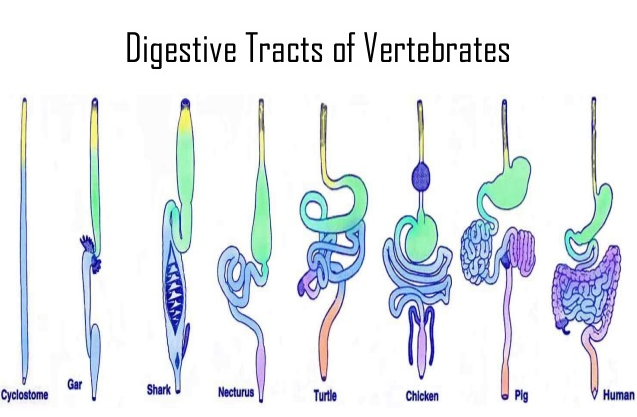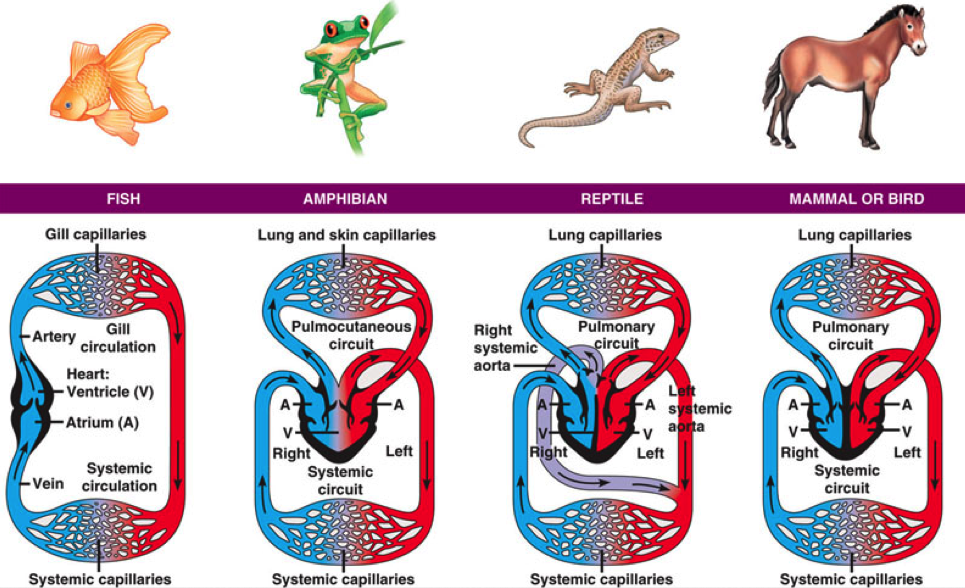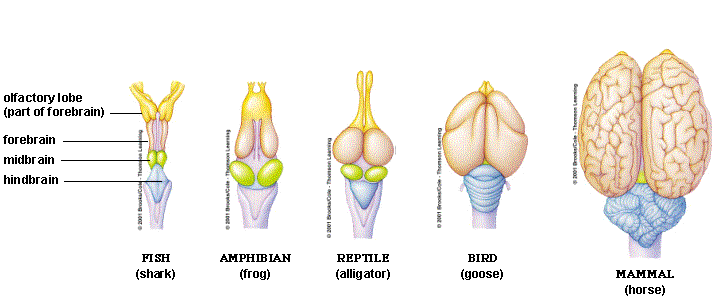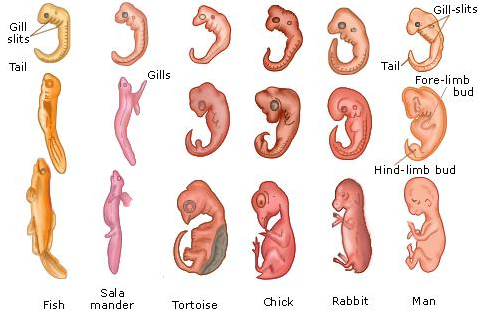What evolutionary trends do you emerging across Subphylum Vertebrata? How do these trends relate to the diversity of the subphylum?
Example: The Digestive System

What do you see?
To put it simply, we see an increase in complexity of the vertebrate digestive system as we move “up” the classes. It is important to remember that moving along from Class Agnatha to Class Chondrichthyes to Class Osteichthyes etc. we are moving closer to the present. Class Agnatha appeared ~550 million years ago while the youngest class (Aves) appeared just ~65 million years ago – that is a period of 500 million years of mutation, adapatation, failure, and success.
What does this complexity mean?
To put it simply again – as the digestive system gets more complex, the availability of food sources increases. For example, Agnathans digestive system isn’t much more than an esophagus. They do not have a stomach to breakdown protein or larger food pieces (they don’t even have jaws to chew and mechanically break down food!). Therefore, Agnathans are extremely limited in terms of diet. However, moving up one class we see the formation of a stomach, which isn’t must more than a U-shaped bend in the intestine. Still, acids/enzymes can breakdown meat and protein. Class Chondrichthyes (Sharks, Skates, Rays, Ratfish) even have jaws for chewing and tearing flesh.
Fast foward to Class Mammalia and we see a more “complete” system. That is we have salivary glands (which moisten and breakdown food), a stomach that is completed separated, a long intestine (which increases the amount on nutrients absorbed), along with a pancreas, liver, gall bladder – all of which release enzymes to breakdown starch and fats. Our digestive system has changed – mammals can access a much larger variety of food sources, we are able to digest more and are more efficient at it. Some mammals can even breakdown cellulose – a plant material through specialized structures called rumen or cecum. Humans used to have a cecum, but it has since been reduced to the now-vestigal appendix (another opportunity to discuss evolution of digestive systems).
Class Aves do not have teeth, however they do have a gizzard – a muscle organ that used gravel to help grind down food. So while birds cannot mechanically breakdown (i.e. chew) their food they have evolved a strategy that mimics the process.
All these changes allowed vertebrates to colonize new niches (habitats) and therefore, we see an increase in diversity of species. The diversity of the digestive system alone predicts the diversity of the subphylum as a whole!
The Circulatory System:

What do you see?
What major evolutionary transition was facilitated by the pulmonary circuit (first seen in Amphibians)? How did this transition lead to an increase in vertebrate diversity?
Evidence of an evolutionary trend can be seen in Class Reptilia – what is it?
Both Class Aves and Class Mammalia have evolved four chambered hearts (separate lineages). The trend towards efficiency can be noted.
Integument:
What adaptations can see in scales? (Agnatha had no scales, but then many other classes did – how did scales change in each class and how does this relate to their environment?)
Both feathers and hair evolved for the same purpose – what was that purpose? (Hint: flight was secondary) Both of these allowed for the colonization of new habitats – what were these habitats?
Cephalization:

This one is more challenging since we did not actively discuss it in class. However, we see a clear development of the fore and hind brain. Think about Mammalian parental care and gestation – this faciliatated brain growth and development and allowed for socialization, language, and many other processes needed for survival and manipulation of our environment.
Embryology:

What do you see?
This one is a little different – we see no (or very little difference) in the first embryonic stages of the vertebrates. This shows us a commonality among vertebrates and the diversification that arises over the development of each. We see each of the four chordate characteristics in each (although these are mostly lost during development!
Additional topics:
- Reproduction/parental care/gestation
- Respiration
- Whatever else you can discuss!
Comments by shaun pletsch